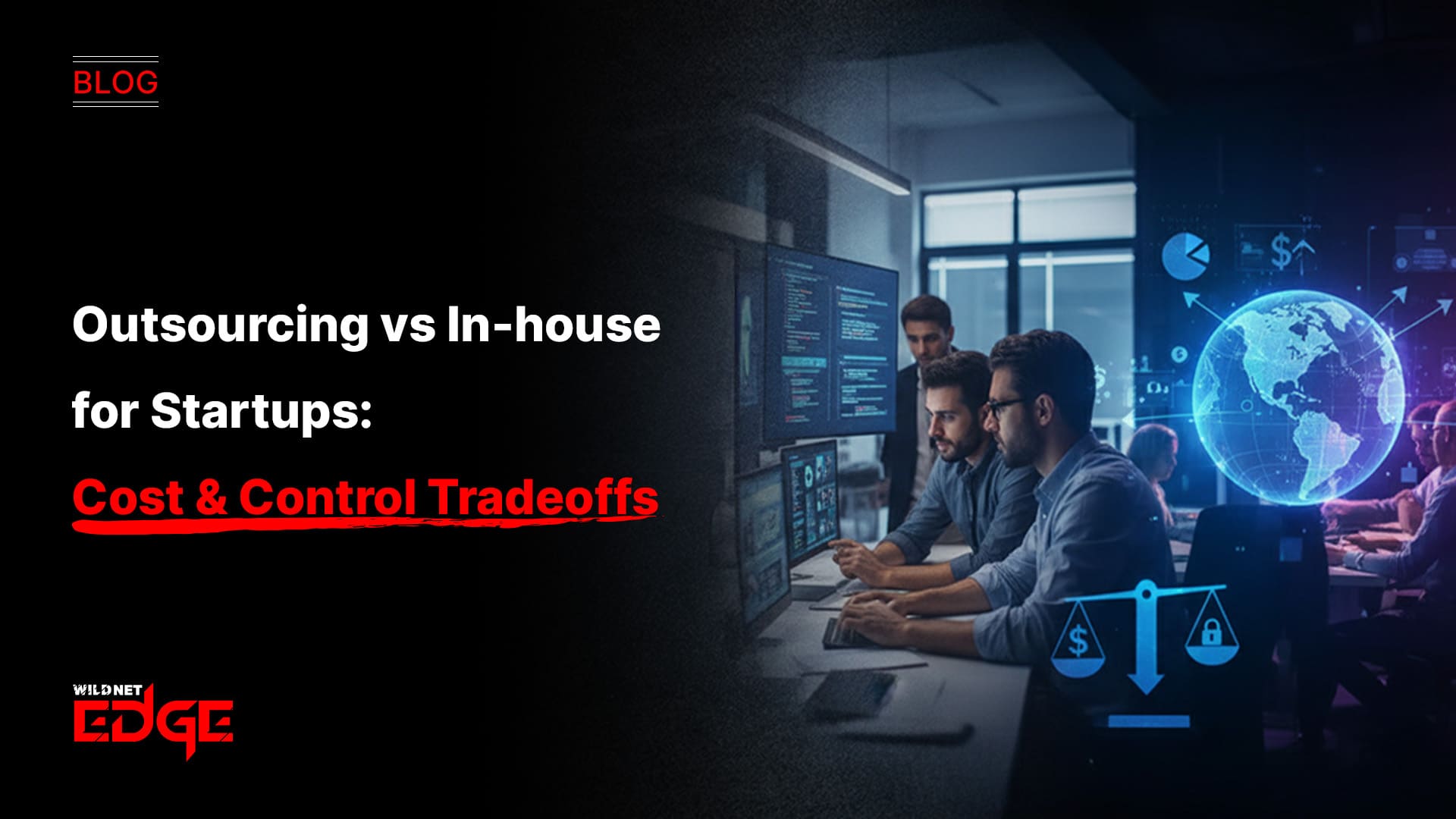TL;DR
This article examines the in-house vs. outsourced software development dilemma for startups. It compares the lower cost and speed of outsourcing with the control and cultural fit of in-house teams. The right choice depends on funding, technical complexity, and strategy outsourcing suits early MVPs, while in-house teams fit post–product–market success.
As a startup founder, choosing how to build your core product is one of your biggest calls. Should you pour resources into hiring and managing your in-house engineering team or partner with an external agency? This in-house vs. outsource software question is tough because it forces you to weigh significant trade-offs: cost, control, speed, and specialized expertise. Knowing these trade-offs is vital when dealing with limited cash and intense pressure to launch. While leaning on startup development outsourcing can offer some compelling perks, it’s essential to understand precisely what you might be giving up.
Understanding the Two Models
- In-House Development: Involves hiring full-time employees, developers, designers, and project managers who work directly for your startup. They are part of your company culture and report to your internal leadership.
- Outsourcing Development: Involves contracting a third-party agency or firm to handle your software development needs. This could be a local agency, an onshore firm in the same country, or an offshore partner. This model often involves discussions around startup software outsourcing.
The Core Tradeoffs: Cost, Control, Speed, Expertise
The decision hinges on how you prioritize these key factors.
1. Cost: Upfront vs. Ongoing
- In-House: Requires significant upfront investment in recruitment, salaries, benefits, office space, and equipment. This creates a high fixed monthly cost, regardless of immediate development needs. Finding and retaining talent is also expensive.
- Outsourcing: Typically involves lower upfront costs. You pay for the development time needed, often on a project or retainer basis. Startup software outsourcing, especially offshore, can offer substantial cost savings on hourly rates. However, costs can escalate if the scope is poorly managed.
2. Control: Direct vs. Managed
- In-House: Offers maximum direct control. Your team is fully integrated, communication is immediate (in theory), and they are solely focused on your product. You dictate the process entirely.
- Outsourcing: Involves less direct, day-to-day control. You rely on the agency’s project manager and processes. Clear communication, well-defined scope, and strong contracts are essential to ensure alignment. Choosing the right partner means trusting their management expertise.
3. Speed: Hiring vs. Starting
- In-House: Can be slow to start. Recruiting, interviewing, hiring, and onboarding a whole team can take months before significant development begins.
- Outsourcing: Offers much faster ramp-up time. An established agency has a ready team of experts and proven processes. You can often kick off a project within weeks, significantly accelerating your time-to-market, especially for an MVP. This speed is a key reason many hire startup developers through agencies.
4. Expertise: Generalists vs. Specialists
- In-House: Early-stage startups often hire generalist developers who can handle various tasks. Building deep expertise in specialized areas (like AI, complex backend architecture, specific security protocols) takes time and may be too expensive initially.
- Outsourcing: Provides immediate access to a pool of specialists. A good agency will have experts in frontend, backend, cloud infrastructure, specific technologies (like AI/ML), and UI/UX design. This allows you to leverage top-tier talent without the cost of full-time hires. This is crucial for complex projects involving, for example, Enterprise App Development.
In-House vs. Outsource Software: A Summary
| Factor | In-House Team | Outsourced Team |
| Initial Cost | Very High | Moderate to Low |
| Ongoing Cost | High Fixed | Variable / Predictable (Project-based) |
| Speed to Start | Slow | Fast |
| Control | High Direct | Moderate Managed |
| Expertise Access | Limited initially | High (Specialists) |
| Scalability | Slow / Difficult | Fast / Easy |
| Cultural Integration | High | Low |
Making the Right Choice for Your Startup Stage
The optimal choice often depends on where you are in your startup journey.
- Idea/Seed Stage (Pre-PMF): Outsourcing is often the most pragmatic choice. Speed to market for an MVP is critical, budgets are tight, and flexibility is key. Startup software outsourcing allows you to validate your idea quickly and cost-effectively. Focusing on lean MVP Development is paramount here.
- Growth Stage (Post-PMF): As your product gains traction and you raise more significant funding, building an in-house core team becomes more viable and often strategically essential for owning the core IP and culture. However, outsourcing can still be valuable for specialized projects or to augment your team during periods of rapid growth.
Our Experience: Helping Startups Succeed
Case Study 1: Seed-Stage Startup MVP Launch
- The Challenge: A non-technical founding team secured seed funding but needed to launch their SaaS MVP within 5 months. Hiring an in-house team would have consumed too much time and capital.
- Our Solution: They chose to outsource startup development to us. We provided a dedicated cross-functional team that worked closely with the founders using an agile methodology.
- The Result: The MVP was launched on time and within budget. The quality of the initial product helped them gain early traction and successfully raise their Series A round 8 months later.
Case Study 2: Scaling a Growth-Stage Platform
- The Challenge: A startup with an existing in-house team needed to rapidly build out a complex new AI-driven feature set for their platform but lacked the specialized machine learning expertise.
- Our Solution: Instead of trying to hire expensive AI specialists quickly, they augmented their team by outsourcing the specific AI module development to our specialized AI team. We collaborated closely with their in-house engineers for seamless integration. This required advanced Custom Software Development.
- The Result: The new feature set was launched 6 months faster than if they had tried to build the expertise internally. The hybrid approach allowed them to leverage specialized external talent while maintaining control over their core product.
Our Technology Stack for Startups
We prioritize speed, scalability, and cost-effectiveness.
- Frontend: React, Vue.js, Flutter
- Backend: Node.js, Python, Ruby on Rails
- Cloud Platforms: AWS, Google Cloud, Firebase, Heroku
- Databases: PostgreSQL, MongoDB
- DevOps: Docker, Serverless Architectures
Conclusion
Deciding between in-house and outsourced software development is a significant choice for any startup founder. There isn’t one perfect solution; it depends on your stage, budget, and goals. For many new companies needing to move fast and save money, outsourcing is a great way to validate ideas and launch quickly.
Ready to explore how outsourcing can accelerate your startup’s journey? At Wildnet Edge, our AI-first approach ensures we build intelligent, scalable Product Development solutions designed for the unique challenges of startups. We act as your expert technical partner, making your vision a market reality.
FAQs
Yes, this is a widespread and often recommended strategy. You can outsource startup development for your MVP and initial growth phases. Once you have product-market fit and secure more funding, you can gradually build your internal team and transition knowledge from the agency.
Maintaining control requires clear communication, a well-defined scope (especially for fixed-price projects), regular check-ins (daily standups), and access to project management tools. Ensuring quality involves working with a reputable agency with a strong QA process and potentially having an internal technical lead review the code.
Your IP is safe if you have a firm contract with a professional agency. Ensure your agreement explicitly states that you own 100% of the intellectual property and source code created for your project. Always sign an NDA.
Beyond salaries, hidden costs include recruitment fees (often 20-30% of the first-year wage), benefits, taxes, office space, hardware, software licenses, training, and the significant management overhead required to build and lead a team.
Speed allows you to start the learning process faster. The sooner you get your MVP in front of real users, the sooner you get feedback, validate (or invalidate) your assumptions, and begin iterating towards product-market fit. Being first can also be a significant competitive advantage.
Look beyond the hourly rate. Evaluate their experience with startups, technical expertise in your required stack, communication processes, client testimonials, and whether their company culture is a good fit for a collaborative partnership.
It can be a challenge initially. However, you can mitigate this by having regular, deep collaboration between your internal team (even if non-technical) and the outsourced developers. Ensure the agency understands your company’s mission and values. Culture can be built intentionally, even with external partners.

Nitin Agarwal is a veteran in custom software development. He is fascinated by how software can turn ideas into real-world solutions. With extensive experience designing scalable and efficient systems, he focuses on creating software that delivers tangible results. Nitin enjoys exploring emerging technologies, taking on challenging projects, and mentoring teams to bring ideas to life. He believes that good software is not just about code; it’s about understanding problems and creating value for users. For him, great software combines thoughtful design, clever engineering, and a clear understanding of the problems it’s meant to solve.
 sales@wildnetedge.com
sales@wildnetedge.com +1 (212) 901 8616
+1 (212) 901 8616 +1 (437) 225-7733
+1 (437) 225-7733































